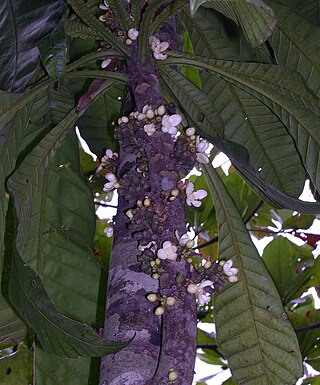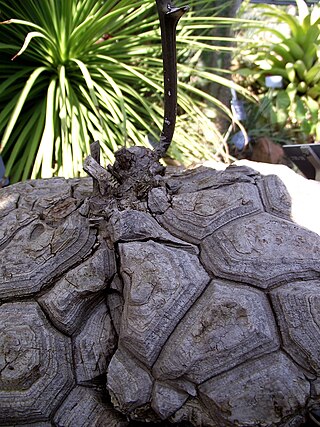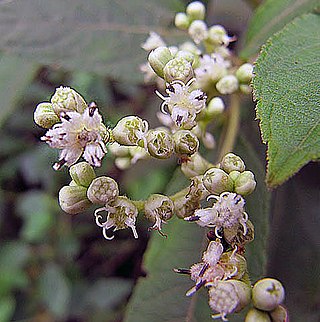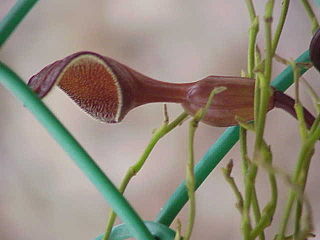
Milla, the Mexican star, is a genus of monocotyledonous plants in the family Asparagaceae, subfamily Brodiaeoideae. They are native mostly to Mexico, with one species extending into Guatemala, Honduras, Arizona, Texas and New Mexico.

Smilax ornata is a perennial trailing vine with prickly stems that is native to Mexico and Central America. Common names include sarsaparilla, Honduran sarsaparilla, and Jamaican sarsaparilla.

Grias cauliflora, the anchovy pear, is an evergreen fruit tree native to Jamaica, Central America, and Colombia. It is often found near rivers or marshes in large colonies. It belongs to the Lecythidaceae family.

Hypoxis decumbens is a species of plant in the Hypoxidaceae, considered by some authors to be included within the Liliaceae or Amaryllidaceae. The species is widespread across South America, Central America, Mexico, and the West Indies.

Dioscorea mexicana, Mexican yam or cabeza de negro is a species of yam in the genus Dioscorea.

Clibadium is a genus of flowering plants in the family Asteraceae.

Brunellia is a genus of trees. They are distributed in the mountainous regions of southern Mexico, Central America, West Indies, and South America. Brunellia is the only genus in the family Brunelliaceae. As of 2001 there were about 54 species.

Acourtia is a genus of flowering plants in the family Asteraceae and was first described as a genus in 1830. It includes desertpeonies, such as Acourtia nana and Acourtia runcinata.

Eleocharis parvula is a species of spikesedge known by the common names dwarf spikerush, small spikerush and hairgrass in aquaria. It is a plant of brackish and saltwater habitat, such as marshes and mudflats. It is a perennial herb growing tufts of spongy, compressible stems not more than 10 centimeters tall. The plant grows from a tuber which is J-shaped or horseshoe-shaped, a characteristic that helps in the identification of the species. The inflorescence is an oval-shaped spikelet just 2 or 3 millimeters long, made up of several tiny flowers.

Telanthophora is a genus of Mesoamerican plants in the groundsel tribe within the daisy family.

Tillandsia balbisiana, common name northern needleleaf, is a species of bromeliad in the genus Tillandsia. This species in native to Mexico, Central America, Colombia, Venezuela, the West Indies, and Florida.

Bixa is a genus of plants in the family Bixaceae. It is native to Mexico, Central America, Caribbean, and South America, and naturalized in other places.

Aristolochia maxima is a plant species native to Central and South America, naturalized in southern Florida. Common names include Florida Dutchman's-pipe (US), canastilla (Guatemala), guaco, and tecolotillo (Mexico). In Florida, it grows in hammocks in the Everglades at elevations below 50 m.

Macroscepis is a genus of plants in the family Apocynaceae, first described as a genus in 1819. It is native to Latin America and the West Indies.
Berberis standleyi is a shrub in the Berberidaceae described as a species in 1952. It was published with the name Mahonia glauca, a very different plant from Berberis glauca. Thus if one desires to consider Berberis and Mahonia as one genus instead of two, it is necessary to use a different name, i.e. Berberis standleyi.

Dimerocostus is a group of flowering plants in the Costaceae described as a genus in 1891. It is native to Central and South America.
Brickellia oliganthes is a Mesoamerican species of flowering plants in the family Asteraceae. It is widespread from northern Mexico south as far as Honduras.

Erechtites valerianifolius, common name tropical burnweed is a New World species of plants in the sunflower family. It is native to Mexico, Central America, South America, and the West Indies. It is also naturalized as a weed in much of the tropical Old World.
Symphoricarpos microphyllus, the pink snowberry, is a North American species of flowering plant in the honeysuckle family. It is widespread across much of Mexico from Chihuahua to Chiapas, and found also in Guatemala, Honduras, and the US State of New Mexico.

Dr. Charlotte M. Taylor is a botanist and professor specialising in taxonomy and conservation. She works with the large plant family Rubiaceae, particularly found in the American tropics and in the tribes Palicoureeae and Psychotrieae. This plant family is an economically important group, as it includes plant species used to make coffee and quinine. Taylor also conducts work related to the floristics of Rubiaceae and morphological radiations of the group. Taylor has collected plant samples from many countries across the globe, including Chile, Colombia, Costa Rica, Panama, and the United States of America, and has named many new species known to science from these regions. As of 2023, Taylor has authored 500 land plant species' names, the third-highest number of such names authored by any female scientist.

















